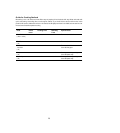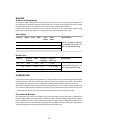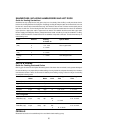
BEVERAGE REHEATING
You can reheat leftover beverages easily and quickly in your oven.
Reheating can be from one cup to three cups. Place cups (mugs) in the oven and press the BEVERAGE pad once for each cup.
When pressing, consult the list below. (Do not use cups with metal trim.)
1 CUP CUP 1 1 cup ( 1 min., 35 sec.)
2 CUPS CUP 2 2 cups ( 2 min., 50 sec.)
3 CUPS CUP 3 3 cups ( 4 min., 20 sec.)
Arrange cups in a ring with space between them when reheating more than two cups. Leave the center empty. After reheating,
remove cups carefully. They may be quite hot.
HOLD WARM
When not serving food immediately after cooking, it can be kept warm by using the Hold Warm function. It keeps food warm by
heating at the lowest power constantly. The Hold Warm mode operates with Stage 1 cooking or independently.
Set the cooking times and power level, then press the HOLD WARM pad. Thereafter, foods can be kept warm properly until
serving. To keep foods warm after conventional cooking, cook food in conventional oven, then press the HOLD WARM pad. See
page 16 for detailed instructions.
HOT SNACKS AND APPETIZERS
Hot hors d'oeuvres and appetizers can be prepared very quickly in the oven by the hostess, or individual servings may be
prepared by guests.
Many appetizers may be cooked on the serving platter, provided the platter does not have metal trim. A time saver tip - prepare
these foods ahead of time, refrigerate or freeze and refresh in the oven at serving time. A plate of appetizers will take only
seconds to prepare or refresh. Cheese melts very rapidly and will toughen if overcooked, so watch foods combined with cheese
closely so that overcooking will not occur. As soon as cheese starts to bubble, cooking is completed. Appetizers that have a
crisp pastry exterior are best prepared in a conventional oven. To prepare appetizers wrapped in bacon, it will be necessary to
precook the bacon and then wrap around the foods. Oysters wrapped in bacon are easier to prepare in the broiler of your
conventional range. Seafood mixtures can be prepared in serving shells as microwave energy will pass through the seafood
shells without heating. Aluminum foil should not be used for shells. If spreads are placed on crackers, care should be taken not
to overcook as moisture from the food will cause crackers to become soggy. Crackers used for spreads should be very dry and
crisp. This helps avoid sogginess. Heat only until spread is at serving temperature. The time required to heat all appetizers will
depend on the amount of food, and the number and the type of dish selected. Remember the food will become very hot even if
the dish is cool. Cheese mixtures retain heat longer when heated with microwave energy.
MEATS
Guide for Auto Weight Defrosting Meats
You may defrost meat within its original plastic wrappings. Remove all metal rings, wire twist-ties and foil wrapping.
Place meat in a microwaveable dish.
Defrost in the microwave oven only as long as necessary, since standing time will complete the thawing process.
23


















